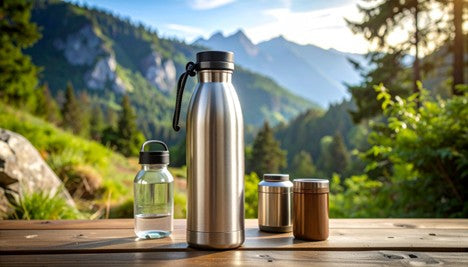Water bottles are essential companions for staying hydrated throughout the day. Whether you’re at the gym, in the office, or on a road trip, having a reliable water bottle ensures you’re never too far from a refreshing sip.
However, choosing the right water bottle can be tricky with so many available options on the market. Stainless steel and plastic water bottles are two of the most common types, each with its own advantages and drawbacks.
This blog aims to provide a comprehensive comparison between stainless steel and plastic water bottles. We will explore their features, benefits, and drawbacks, and help you decide which one is the best choice for your daily hydration needs.
What is a Stainless-Steel Water Bottle?
Stainless steel water bottles are made from high-quality food-grade stainless steel, typically 18/8 or 304-grade, known for its excellent corrosion resistance and durability. These bottles are often designed with a double-walled, vacuum-insulated construction that allows them to keep beverages cold or hot for extended periods.
Features of Stainless-Steel Water Bottles
- Durability: Stainless steel is a tough material that can withstand drops, impacts, and extreme conditions without cracking or breaking.
- Temperature Retention: Double-walled vacuum insulation ensures that hot drinks stay hot for up to 12 hours and cold drinks stay cold for up to 24 hours.
- Health and Safety: Stainless steel water bottles are free from harmful chemicals like BPA, phthalates, and other toxins. They don’t leach chemicals into the contents of your bottle, ensuring safe hydration.
- Non-Reactive: Stainless steel doesn’t react with the liquids inside, preserving the taste and quality of the beverage.
- Eco-Friendly: Reusable and recyclable, stainless steel bottles are a sustainable alternative to single-use plastic bottles. By using a stainless-steel bottle, you reduce waste and contribute to a healthier planet.
What is a Plastic Water Bottle?
Plastic water bottles are made from various types of plastics, including PET (Polyethylene Terephthalate), HDPE (High-Density Polyethylene), or BPA-free plastics like Tritan. These bottles are incredibly popular because they are lightweight, affordable, and easy to find. They come in various sizes, colors, and designs, making them a flexible option for everyday hydration.
Features of Plastic Water Bottles
- Lightweight: Plastic water bottles are significantly lighter than stainless steel bottles, making them easier to carry, especially for children or travelers who prioritize portability.
- Affordable: Plastic bottles are typically less expensive than stainless steel bottles, making them a budget-friendly option.
- Variety: Plastic water bottles come in a wide range of designs, shapes, and colors. Some are designed to be disposable, while others are made to be reusable.
- Chemical Concerns: Although many plastic bottles are BPA-free, some may still contain other chemicals like phthalates, which can leach into your drink over time, especially if the bottle is exposed to heat or sunlight.
- Lifespan: While reusable plastic bottles are designed to be durable, they are generally not as long-lasting as stainless-steel bottles. They can crack, stain, and degrade over time.
Stainless Steel vs Plastic: Durability & Longevity
Stainless Steel: Stainless steel is known for its durability. It can withstand the rough and tumble of everyday use without showing signs of wear and tear. Stainless steel water bottles are resistant to cracking, breaking, and staining. They are ideal for those who need a bottle that will last for many years.
Plastic: Plastic water bottles, on the other hand, are more prone to wear and tear. While some high-quality reusable plastic bottles are designed for durability, they can still crack, warp, or lose their structural integrity over time, particularly when exposed to high temperatures or UV rays.
Verdict: Stainless steel bottles are more durable and have a longer lifespan than plastic bottles.
Stainless Steel vs Plastic: Health & Safety
Stainless Steel: Stainless steel is a safe and non-toxic material. Unlike plastic, stainless steel does not contain BPA, phthalates, or other harmful chemicals that can leach into your water. Stainless steel is a non-reactive material, which means it will not alter the taste or quality of your drink.
Plastic: Plastic bottles are often made with BPA, phthalates, or other potentially harmful chemicals, although many manufacturers now offer BPA-free plastic bottles. However, even BPA-free plastics can leach other chemicals, especially when exposed to heat or sunlight. Additionally, plastic bottles can harbor bacteria and other pathogens if not cleaned properly.
Verdict: Stainless steel bottles are generally safer, as they do not leach chemicals into your water.
Stainless Steel vs Plastic: Environmental Impact
Stainless Steel: One of the biggest advantages of stainless-steel bottles is their environmental impact. Stainless steel bottles are durable, reusable, and recyclable. By using a stainless-steel water bottle, you significantly reduce your contribution to plastic pollution. Stainless steel bottles also have a long lifespan, meaning you don’t need to replace them frequently.
Plastic: Plastic bottles are a major contributor to environmental pollution. Even though many plastic bottles are recyclable, the vast majority end up in landfills or the ocean. Plastic bottles are also made from petroleum-based products, which contribute to the depletion of natural resources. Reusing plastic bottles can mitigate some of the environmental impact, but the overall environmental cost of plastic remains high.
Verdict: Stainless steel bottles are much more eco-friendly than plastic bottles.
Stainless Steel vs Plastic: Temperature Retention
Stainless Steel: Stainless steel water bottles, especially those with double-walled vacuum insulation, excel at temperature retention. They can keep cold beverages cold for up to 24 hours and hot beverages hot for up to 12 hours. This makes stainless steel bottles ideal for people who want to keep their drinks at the perfect temperature throughout the day.
Plastic: Plastic bottles do not offer any insulation. As a result, they do not retain the temperature of your drink. Your cold water will warm up quickly in a plastic bottle, and hot drinks will lose heat just as fast.
Verdict: Stainless steel bottles are far superior in terms of temperature retention.
Stainless Steel vs Plastic: Weight & Portability
Stainless Steel: Stainless steel bottles are generally heavier than plastic bottles, especially those with double-wall insulation. While some modern stainless-steel bottles are designed to be lightweight, they are still heavier than plastic bottles. If weight is a major concern, stainless steel may not be the best option for you.
Plastic: Plastic bottles are much lighter than stainless steel bottles. This makes them easy to carry around, especially for children, casual users, or travelers who need something light and portable. If weight is a priority, plastic bottles are the better choice.
Verdict: Plastic bottles are lighter and more portable than stainless steel bottles.
Stainless Steel vs Plastic: Cost & Affordability
Stainless Steel: Stainless steel water bottles tend to be more expensive upfront. However, their durability means that you won’t have to replace them as often. Over time, the higher initial investment pays off, making stainless steel bottles a cost-effective choice for long-term use.
Plastic: Plastic bottles are much cheaper, which makes them more accessible for people on a budget. However, because plastic bottles are less durable and need to be replaced more frequently, the long-term cost can add up.
Verdict: Plastic bottles are cheaper initially, but stainless-steel bottles offer better long-term value.
Pros & Cons Comparison
|
Feature |
Stainless Steel |
Plastic |
|
Durability |
Highly durable, long lifespan |
Less durable, prone to damage |
|
Health & Safety |
Chemical-free, non-reactive |
May leach harmful chemicals |
|
Unless you buy from reputed international brands |
||
|
Environmental Impact |
Eco-friendly, recyclable |
Contributes to pollution, not easily recyclable |
|
Can instead choose recycled plastic bottle |
||
|
Temperature Retention |
Excellent insulation |
Poor insulation |
|
Weight |
Heavier |
Lightweight and portable |
|
Cost |
Higher initial cost |
Lower initial cost |
|
Lifespan |
Years of use, long-lasting |
Shorter lifespan, needs frequent replacement |
Which One Should You Choose?
The decision between stainless steel and plastic water bottles depends on your priorities:
- Choose Stainless Steel if you value durability, health safety, temperature retention, and environmental sustainability. It’s perfect for those who want a long-lasting, high-performance water bottle.
- Choose Plastic if you prioritize affordability, lightness, and portability. Plastic bottles are ideal for those who need a low-cost, lightweight option for short-term use.
Find Quality Water Bottles at Innovix Home
Whether you prefer the durability and sustainability of stainless steel or the convenience and portability of plastic, Innovix Home offers a selection of premium hydration solutions from trusted international brands. Explore our curated collection to find the perfect water bottle for your needs.
Both stainless steel and plastic water bottles have their merits, but ultimately, your choice depends on your lifestyle, needs, and values.
For those seeking long-term durability and environmental impact, stainless steel is the way to go. If you need something lightweight and budget-friendly, plastic might be a better option. Whichever you choose, make sure you invest in quality for both your health and the environment.
















